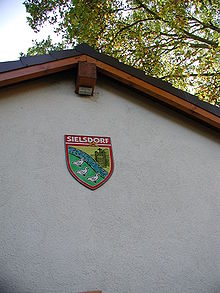Sielsdorf
With 376 inhabitants (as of October 31, 2008), Sielsdorf is the smallest district of the city of Hürth in the Rhein-Erft district in the south-west of Cologne .
geography
Sielsdorf is located in the fertile Cologne arable plain, it is traversed by the Gleueler Bach , which also fills the trenches of the old estate of the place, the Hubertushof.
history
Sielsdorf is first mentioned in a document as Selstena in 898 (see Gleuel ). It belonged to the church and place Gleuel until modern times.
Already in the early Middle Ages one of the mills driven by the Gleueler Bach in the Hürth area is mentioned in documents from 1267 and 1324 . As was customary at the time, the mills were run by tenants. The owner of the Sielsdorfer Mühle was the St. Pantaleon Abbey (Cologne) . Later in the 16th and 17th centuries, some of the millers were named in the Gleuel parish register. An Elisabeth Nissen, wife of the miller Hermann Bachem, was most likely identical to the person who was burned as a witch in Gleuel in 1637 after cruel torture . During the Napoleonic era, the mill was secularized with its 19 acres of land in 1802 .
There were two other large estates in the vicinity of the mill at this time. These were the Hubertushof, which belongs to the St. Aposteln Abbey in Cologne and still exists today, with 200 acres of arable land at the time, and the Reuschhalfenhof, which was abandoned in the 19th century, with 170 acres of land. This belonged to the Cologne cathedral chapter . Only a few houses for the court servants and small farmers came to these farms. In 1831 Sielsdorf had 14 fire places and just 67 residents.
The industrial history of today's city of Hürth begins in Sielsdorf around 1835. The self-proclaimed "factory owners" Peter Jüssen and Jakob Sons bought the old water mill and converted the previous grinding mill into a paper factory where they produced coarse wrapping paper. The apparently not flourishing business of the small factory forced to give up after a few years. In 1855 this company was acquired by Johann Classen-Kappelmann , a Cologne entrepreneur. He installed a modern gas-fired steam boiler, replaced the water power with it and thus made the first step into the industrial age in the area of the mayor's office in Hürth. Today the factory building has been converted into a residential complex. This residential complex still has its own laws. In 2004, the midday rest was abolished there, which offers the children of the village paradisiacal opportunities to let off steam.
Infrastructure
Sielsdorf may have a larger population than Knapsack , but as an industrial and commercial-free place, it is a preferred residential area that has only been carefully expanded. By the Second World War , the place had grown to almost 200 inhabitants. By expanding with a few single-family houses, it had around 370 inhabitants at the beginning of the 21st century. The Hubertushof is significant as a goose courtyard with direct sales as well as an inn / restaurant on Kölner Strasse.
politics
Today, Sielsdorf forms a district with Stotzheim. The mayor there is Otto Winkelhag (CDU).
Curiosities
Sielsdorf is on the Kölner Strasse (K3) leading to Cologne-Lindenthal , which is used by many commuters . Years ago, a radar-controlled camera for speed monitoring, a so-called “star box”, was set up on this at the entrance to the town in the direction of Cologne . An unofficial coat of arms was designed by Friedhelm Konsorski through the local community (since 1950). This coat of arms shows the "Sielsdorfer Gänse" from Hubertushof in the left area, diagonally the Gleueler Bach flowing through the village and on the right the wayside shrine "Sielsdorfer Fußfall" from 1850 . The place name Sielsdorf is of course above this arrangement. The letter “O” contained in the word was represented as a stylized camera with a radar flash underneath. This coat of arms is on the gable of a small club building that is used for storage purposes.
Famous Sielsdorfer
The writer Tilman Röhrig , winner of the culture award of the city of Hürth, has lived in Sielsdorf since 1977 .
literature
- Max-Josef Midunsky: From the story of Hürth-Sielsdorf. in commemorative publication of the Sielsdorf community , 1975, (Hürth City Archives)
- Manfred Faust The Sielsdorfer Mühle, a surprising chapter of Hürth's industrial history , in Hürth's homeland, vol. 76, 1977
Individual evidence
- ↑ Klemens Klug, Hürth, how it was, how it was Cologne, no year (1962), p. 160
- ↑ Status 1948: 192 from Chronicle Sielsdorf
- ↑ According to the city of Hürth website as of June 2014
Web links
Coordinates: 50 ° 54 ' N , 6 ° 51' E



